The Albarrán Family's Memorable MUDEC Year
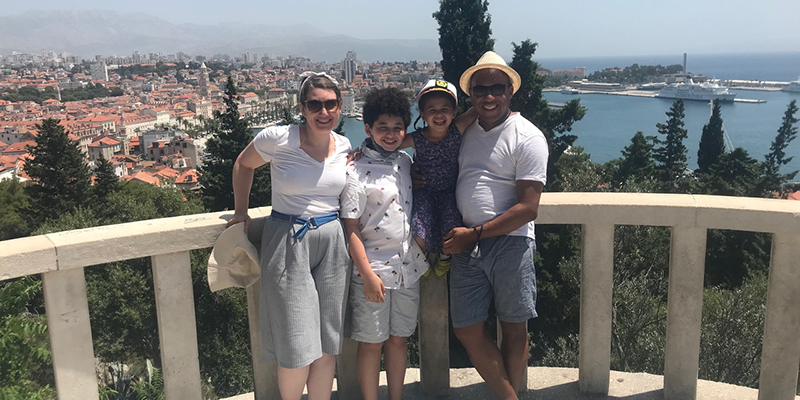

Visiting Croatia
by Karen O'Hara, Global Initiatives
For over 50 years, Oxford-based professors have taught at the Miami University John. E. Dolibois European Center (MUDEC) in Differdange, Luxembourg for a semester or more. Accordingly, many professors bring their families along, enrolling their children in local schools and finding a suitable place to live.
But when Professors Juan Carlos L. Albarrán (Global and Intercultural Studies) and Elena Jackson Albarrán (History/Global and Intercultural Studies) applied to teach at MUDEC for the 2020-21 academic year, they had one more thing to consider: a pandemic.
Elena Albarrán described that time as a bit of a blur. "Some of the bureaucratic roadblocks were stunning, and were certainly strung out due to pandemic office shortages. All of that was compounded by the different pace of work on the calendar year between the US and central Europe in terms of vacation and holiday schedules," she said.
"We thought the pandemic might mean the program would close," said Juan Carlos Albarrán. "We did not know until two months before that we were officially going. It impacted our timeline in many different ways from securing a renter for our home to the uncertainty of how the pandemic would unfold in a new place."
But that initial uncertainty gave way to the opportunity of a lifetime for this Miami family. We caught up with the Albarráns as they neared the end of an eventful year spent in Luxembourg.
Why did you want to teach at MUDEC?
EJA: My work and life experiences have always been oriented towards the Americas, but as I have recently begun to branch out into research and teaching areas that look at comparative histories of childhood and youth, and processes of transnationalism, I began to seek out opportunities to expand my professional horizons. Teaching at MUDEC gave me the opportunity to teach new classes in thematic areas that I know about but with a European-focused framework. I read a lot of new materials and learned an enormous amount in the process of preparing for an entirely new courseload at MUDEC.
We adjusted our course offerings to align with the curricular design of MUDEC. In the end, it was really fun and rewarding to find local ways to integrate European histories, realities, cultural practices, migration patterns, models of development, and generational legacies into the courses that we taught.
JCLA: I wanted to use the opportunity to teach and live in Europe and the MUDEC model presents a very unique opportunity as it is teaching our own Miami students in a European context. I also wanted to use Europe as a more contemporary area of studies that I do not normally work on.
What challenges did you and your family face?
JCLA: The biggest challenge was that we made the decision to come in the middle of the pandemic and there was not a lot of clear vision moving forward with the vaccines at that time. It was also an election year in the U.S., which presented us with another logistical aspect of our trips we needed to deal with.
We were also not sure of the new school system: how would the children adjust to a new school, friends, new languages, extra-curricular activities, doctors, medication, etc.? Because we were living in the Château, we would not be able to have neighbors. The time difference would also limit our online connection with the people back home, including the work-related things like contacting IT or attending a Zoom department meeting.
Meet the Albarráns
Elena Jackson Albarrán
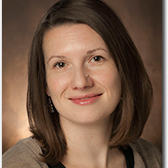
Associate Professor jointly appointed in History and Global and Intercultural Studies. PhD in History from University of Arizona. Specialist in Latin American history, revolutions, and history of childhood and youth.
Juan Carlos L. Albarrán
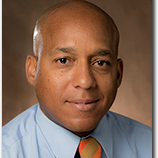
Associate Lecturer, Global and Intercultural Studies (Latin American, Latino/a, and Caribbean studies. MA from University of Arizona. Specialist in sustainable tourism, refugee migration, and social entrepreneurship.
EJA: Settling our children into the school system actually ended up being the least of our concerns. They both attend two different campuses of the International School, and both are just steps away from the Château. They’ve both found a wonderful network of friends, are learning in a very multicultural environment, and most importantly, had face-to-face classes for most of the year, with a few quarantine interruptions.
What was it like to live at the Château?
JCLA: We lived at the “Madison” apartment on the 2nd floor. It is a very modern apartment, with all the basic needs for our family. It made it very easy to go from our private space to our professional day-to-day activities. It is also challenging because you do not get to distance your personal and professional life as much.
What courses did you teach?
EJA: I taught HST 296, World History since 1945, in a condensed format. The themes of this course were Cold War politics, race and racism in Europe, and the transformative power of youth mobility (travel for political, service, or social reasons).
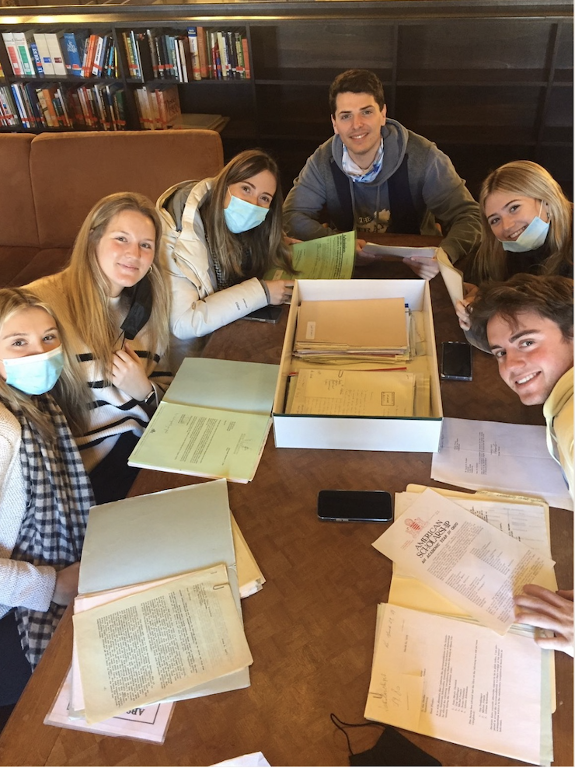
Students working in the MUDEC archives
As a special feature of this class, I dragged the MUDEC paper archives out of the attic: box upon box of documents related to the program’s administration, dating back to its inauguration in 1968. Students got a rare opportunity to do hands-on archival research and track past MUDEC student travel through Cold War Europe in light of their own travel adventures. They found considerable comparisons to be made between the Cold War-era travel restrictions that many youth faced and the COVID-era restrictions (and re-closing of national borders) that they were experiencing in 2020-1.
My goal is to bring the archive back to Oxford to have it integrated into the University Archives at Special Collections, since it holds a wealth of institutional knowledge and documents Miami student globalization in a critical era in twentieth century world history.
I also taught HST 250L, Comparative Cold War Childhoods, a class that I designed out of my research interests, that looked at the different dimensions of growing up on both sides of the Iron Curtain from 1946-1991. We looked at political propaganda, education systems, popular culture, media, children’s literature, and other domains of childhood to trace the shape of three different generations coming of age in the Cold War. An important feature of this class was an oral history project conducted with a family member or close contact about their experiences growing up in the context that we were studying. This project gave our class a uniquely personal dimension.
JCLA: I taught a sprint course GIC 101 Refugee: The New Face of Europe during the regular semesters and as a summer course. One of the highlights was visiting a restaurant in Esch-Sur-Alzette named Chiche. There the owner of the restaurant has a project to help refugees to find employment in the service industry. One of the workers in the restaurant was Yannick Herve, a refugee from Cameroon. He shared his powerful story of migration to Luxembourg with the students at the restaurant.
We also visited the Center for Refugee Migration and learned from researchers about historical migration to Luxembourg from Russians during the Russian Revolution of 1917 to today's migrations of Portuguese and Eritreans. Students met with Teresa Miranda, director of the Red Cross in Differdange, to hear about the services they provide for those in need in Luxembourg. Each semester, our students collected clothing and other goods to donate to the Red Cross.
Our summer class was able to meet one of the two Syrian refugee families living in Zadar, Croatia and had a very unique experience learning about the challenges and opportunities of refugee life in a new country. I think this opportunity of teaching the class in Europe was a learning experience for us all.
Did you work on any other projects?
JCLA: While in Europe most of the projects I worked on were connected with the refugee class I was teaching. I was also teaching my regular class load in Oxford, so I was involved in different activities and projects with the Oxford campus while in Luxembourg.
EJA: As part of restoring order to the MUDEC archive, I spent time identifying projects that the archive could be useful for. And since we were relatively confined to the Château for most of the fall and all of the winter, I was able to make progress on some other research projects. I completed a draft manuscript of my second book project (on transnational exchanges between children of the Americas in the early twentieth century), and finished up some articles and a book review.
I am also working on presenting the oral history projects completed by the students in HST 250 as part of a Decolonial and De-Cold War Childhood conference this October. The memories that students collected from their friends and family members will be incorporated into a global memories database that has been part of an ongoing research collective to which I belong.
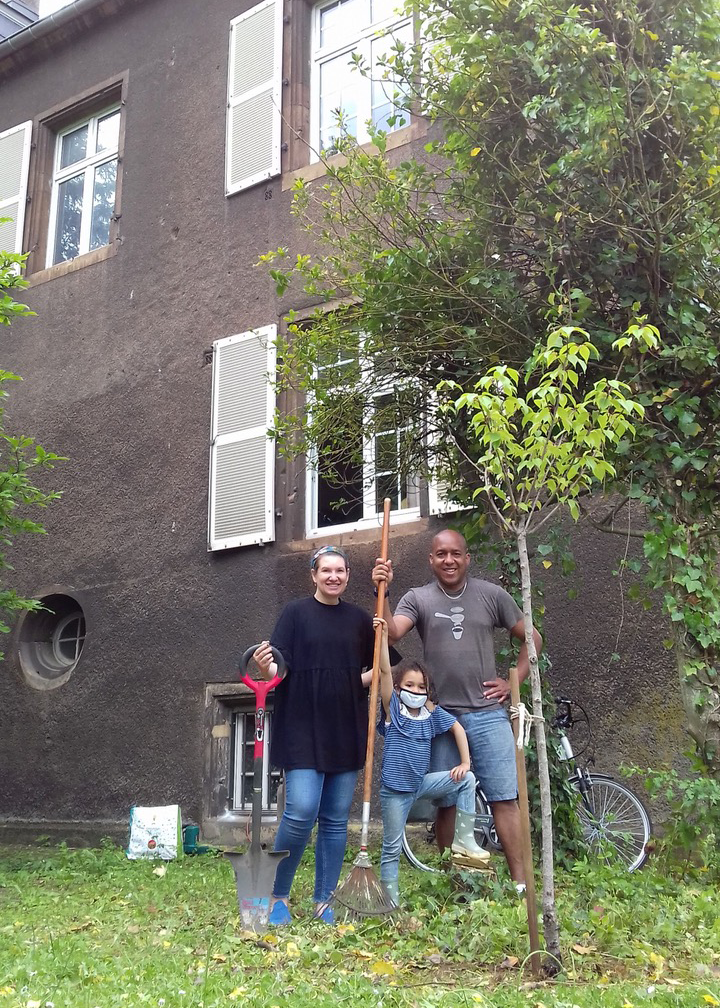 This part of Europe has been experiencing some devastating effects to the forests due to droughts, extra-hot summers, and climate change, and we witnessed the city cut down dozens and dozens of dead or severely unhealthy trees in the immediate environs of theChâteau. We organized a tree planting for the spring semester students to commemorate Earth Day, in a small and symbolic gesture to help reforest this beautiful piece of land, and then we added a family tree of our own to the grounds, in close consultation with the incomparable groundskeeper Guy Graul. Planting a tree is a tradition that we hope future cohorts of MUDEC students will continue, by leaving a lasting mark in exchange for the permanent imprint that Luxembourg will no doubt leave on them.
This part of Europe has been experiencing some devastating effects to the forests due to droughts, extra-hot summers, and climate change, and we witnessed the city cut down dozens and dozens of dead or severely unhealthy trees in the immediate environs of theChâteau. We organized a tree planting for the spring semester students to commemorate Earth Day, in a small and symbolic gesture to help reforest this beautiful piece of land, and then we added a family tree of our own to the grounds, in close consultation with the incomparable groundskeeper Guy Graul. Planting a tree is a tradition that we hope future cohorts of MUDEC students will continue, by leaving a lasting mark in exchange for the permanent imprint that Luxembourg will no doubt leave on them.
Tell us about the adjustments your family made to life in Differdange
EJA: The bread and pastries! We will never be the same. Aside from that, we have really enjoyed being car-free for the year, and have taken full advantage of the completely free national transportation network that is wonderfully clean, efficient, and reliable. It helps us to imagine a less carbon-intensive lifestyle back at home, and we hope to bring an aspect of that back with us when we return.
We did not make much progress with Luxembourgish, although we might have done better had we been able to socialize more with other parents or contacts in a non-COVID context. In the late spring and now in the summer, things have begun to improve socially and more people are circulating in the streets, but the social situation for much of the academic year was really limited to just a lot of very intensive family time.
JCLA: There have been many things we needed to adjust to since our arrival. The classes for our children's International School start later than in Oxford (mid-September) and end in mid-July. They study languages as part of their curriculum, and that is different from what we have in our school system in the U.S.
As a country with a very strong welfare system, Luxembourg provides a lot of services that the residents can take advantage of. We were able to take our kids to practice sports like gymnastics and soccer. In Luxembourg, children need to pass a thorough physical exam run by a specialized sports health clinic before they can participate in any matches with their league.
Where did you travel during your time at MUDEC?
EJA: In the fall, I took my students on a study tour to Berlin, which was the perfect place to witness the convergence of the Cold War ideologies and built environments in one city. Highlights included a day spent biking through the city, a riverboat cruise through the city, and a day on the outskirts of the city in an abandoned tuberculosis sanatorium that has been converted into a state park.
In the spring, the entire MUDEC cohort combined all three study tours into one mega-tour of coastal Croatia, one of the only places available for us to travel to in COVID times. As part of former Yugoslavia, which was the headquarters of the Non-Aligned Movement, Croatia ended up being the perfect place to study Cold War geopolitics and culture.
COVID restrictions meant that our personal travel was severely limited. We barely forayed beyond Luxembourgish borders at all, which at first was quite a disappointment given our expectations to explore Europe. However, in exchange, we’ve gotten to know Luxembourg extremely well, and feel like we’ve gotten a privileged view of the country’s diverse landscapes, built environments, and civil structures. I’ve fallen in love with the overgrown post-industrial moonscape of the Minnett region (Luxembourg’s southern region that housed the mining industry.) The UNESCO-protected fortified city of Luxembourg is the most overlooked and underrated European city I’ve ever been to, and reveals new treasures each time we visit.
The Moselle River valley on the border with Germany was absolutely intoxicating, and I can hardly imagine a more peaceful site for a getaway. The bike paths are exquisitely maintained and networked. We easily (and accidentally) biked into France one day, and Belgium another day, and wove in and out of Germany on yet another day. We rented a car and drove through the Valley of the Seven Castles, and rated each one on a scale created by our son. Since we weren’t lured away by the misleading proximity (when looking at a map) of Stockholm or Lisbon, we focused our weekends on Luxembourg and really maximized our time.
JCLA: The COVID pandemic has been a challenge for the European Union in terms of the “Open Borders” policy and trying to control the spread of COVID. I might have to put Croatia as one of my favorite places after visiting that country.
The area of Remich and Remerschen in Luxembourg is really beautiful with some hiking, river walks, wine tasting, etc. making it a very unique area to visit. This is probably one of the areas we enjoyed the most while in Luxembourg. We took a family bike ride along the Moselle River overlooking the vineyards that was breathtaking. We also got to see the biodiversity center and are with some of the preserve lands that not only has a range of birds, plants, and also historical sites like Roman points of trade, making this a great experience.
What was your favorite local shop to visit?
EJA: There is a wonderful stationery store in nearby Esch that has a stunning array of pens. I think that the most expensive one I saw was 1400 Euros. I splurged and purchased one for 20 Euros. One train station away, there is a meat and dairy farm that has a little untended shop where you can buy a litre of fresh cream that you dispense into your own container, and pay in coins by the honor system.
JCLA: I think my favorite place to go was Boulangerie-Patisserie Berto here in Differdange. There is nothing better than getting up in the morning and walk to Boulangerie-Patisserie Berto and get a fresh baguette, a fresh croissant, or an eclair. At one point before the restaurants were closed due to COVID, I would go and have a fresh squeezed orange juice, a cappuccino, and a croissant; nothing beats that. Now, there are others like Fischer, Bartholome, or Paul’s but my favorite was that Berto.
What were some of the most surprising or memorable moments?
EJA: One of the most memorable moments was a field trip that I took with my HST 296 class to Schengen (where the Schengen Treaty was signed to remove border restrictions in the European Union, and where France, Germany, and Luxembourg all meet), and the overnight youth hostel stay nearby. During our trip, I transported them back to 1984 (before the Schengen Treaty was signed), and we had a night of 1984-style hostel socialization. I took away their phones, they made and played a mixtape, and we did arts and crafts, word games, and chess, while we talked politics. It was a refreshing step into past modes of travel and socialization, and took place in one of the classic sites for international exchange and intercultural growth: a youth hostel.
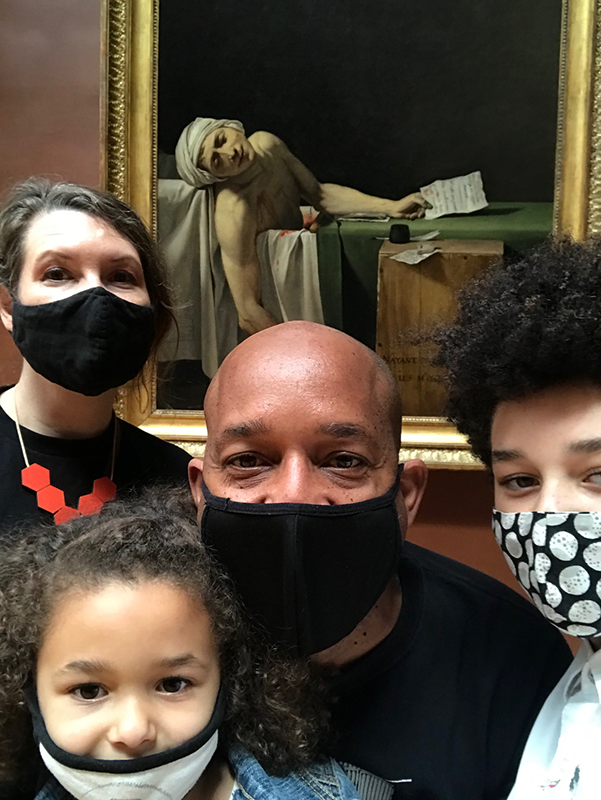
At the Louvre
Another very rewarding moment was very recently, when we were finally able to take our first trip to Paris for a weekend. One of the principal motivations for our son (age 11) to come to Europe was to see one of only a handful of extant Vermeer paintings, after he had read a book about Vermeer and unsuccessfully trekked to Detroit and Chicago in hopes that there would be one there. We went to the Louvre, and tracked down the two Vermeers in the collection, which delighted and validated him. We also found The Death of Marat, a painting which we had reenacted as a family in my office bathtub (perks of living in the Château: there is a bathtub in my faculty office!)
JCLA: I have enjoyed all the integration trips coordinated by MUDEC. Those trips helped us ground ourselves with the history of the region from medieval historical landmarks like the Vianden château to the American and Germany WWII cemeteries. There is a lot to see in Luxembourg and we learned that from our first trips.
I enjoyed a lot of the activities organized by MUDEC and SFC too. I enjoyed seeing the Luxembourg Symphonic Orchestra last fall, hearing about dissident art in Russia, and cleaning all the green areas of the Château with the students on Earth Day.
What are some of the ways the pandemic affected your family's life?
JCLA: It was a very challenging time for us personally. I got COVID over Thanksgiving and then our kids got COVID, so we spent most of our winter break in quarantine in the Château.
I think another way that COVID has impacted my life at MUDEC has been the limits it put in how I have to change some of the activities I wanted to do with my students, like visiting the UNHCR in Brussels. It also limited the opportunity to build camaraderie with the MUDEC faculty due to social distancing.
EJA: We had to have a lot of COVID tests, and there was a lot of uncertainty, especially in the fall. The long back-to-back quarantines in the deep rainy gray winter months were especially emotionally challenging, and it was hard to remain optimistic, creative, and productive.
But sometimes we played hide and seek in the Château. We found a very old Christmas tree in one of the cabinets and decorated it with paper chains that we had colored with splatter paint, all from materials found in the classrooms. We cooked a lot. I suppose that it’s not that different from how most people back home spent the winter COVID months, so we don’t feel too badly that our dreams of wintering in Spain and Portugal were unrealized.
What are your plans as you return to the U.S.?
EJA: I will return service commitments in both of my departments of History and Global and Intercultural Studies. I’m going to be a faculty scholar participating in this year’s Altman series on Race and Racism, and look forward to those conversations with colleagues. I have sorely missed my colleagues and the generative, fun, collaborative things that we always cook up together, so I’ll be looking forward to department life again. I’m especially looking forward to helping to grow the Latin American, Latino/a, and Caribbean Studies program back to healthy numbers, and to teaching courses on Latin America.
JCLA: I think I would like to enjoy my home space a little more once I get back. My immediate future involves a summer project called the Study of the United States Institutes (SUSI) by student leaders. It is a program sponsored by the State Department and the Education and Cultural Affairs (ECA) that allows for students from marginalized regions of Latin America to come to the U.S. to learn about the U.S. institutions and bring some of these ideas back home to empower people in their countries.

